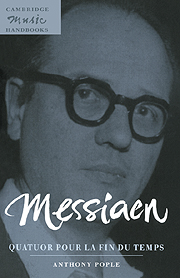Book contents
- Frontmatter
- Contents
- Acknowledgements
- Introduction
- 1 ‘Liturgie de cristal’
- 2 ‘Vocalise, pour l'Ange qui annonce la fin du Temps’
- 3 ‘Abîme des oiseaux’
- 4 ‘Intermède’
- 5 ‘Louange à l'Éternité de Jésus’
- 6 ‘Danse de la fureur, pour les sept trompettes’
- 7 ‘Fouillis d'arcs-en-ciel, pour l'Ange qui annonce la fin du temps’
- 8 ‘Louange à l'Immortalité de Jésus’
- 9 Contexts
- Appendix: Messiaen's modes à transpositions limitées
- Notes
- Select bibliography
- Index
7 - ‘Fouillis d'arcs-en-ciel, pour l'Ange qui annonce la fin du temps’
Published online by Cambridge University Press: 05 June 2012
- Frontmatter
- Contents
- Acknowledgements
- Introduction
- 1 ‘Liturgie de cristal’
- 2 ‘Vocalise, pour l'Ange qui annonce la fin du Temps’
- 3 ‘Abîme des oiseaux’
- 4 ‘Intermède’
- 5 ‘Louange à l'Éternité de Jésus’
- 6 ‘Danse de la fureur, pour les sept trompettes’
- 7 ‘Fouillis d'arcs-en-ciel, pour l'Ange qui annonce la fin du temps’
- 8 ‘Louange à l'Immortalité de Jésus’
- 9 Contexts
- Appendix: Messiaen's modes à transpositions limitées
- Notes
- Select bibliography
- Index
Summary
Certain passages from the second movement return. The mighty Angel appears, and above all the rainbow which crowns him (the rainbow: a symbol of peace, wisdom and of all sounding and luminous vibrations). In my dreams, I hear recognised chords and melodies, I see known colours and forms; then, after this transitory stage, I pass beyond reality and submit in ecstasy to a dizziness, a gyratory interlocking of superhuman sounds and colours. These swords of fire, these flows of blueorange lava, these sudden stars; this is the tumult of rainbows!
This climactic movement is the only one in which contemplation is subordinated to the depiction of events in a definite sequence. The principal musical consequence is that the formal structure of the music acquires something of the teleological quality that we associate with the sonata principle in the Austro-German tradition. But Messiaen's own description of the form – ‘variations of the first theme, separated by developments of the second’ – makes it clear that his conception falls short of the dialectical interplay of themes and tonalities that post-Beethovenian sonata form frequently embodies. Nonetheless, the very idea of ‘development’ alerts us to something that distinguishes the treatment of themes in ‘Fouillis d'arcs-en-ciel …’ from, for example, the linkage through complementary aspects of plainsong between the melodic materials at ii/B:1–3 and D:1ff. in ‘Vocalise …’ (see pp. 29–31).
Developments
The comparison with the second movement is particularly germane because, as Messiaen makes clear, much of its material reappears here.
- Type
- Chapter
- Information
- Messiaen: Quatuor pour la fin du temps , pp. 72 - 80Publisher: Cambridge University PressPrint publication year: 1998



